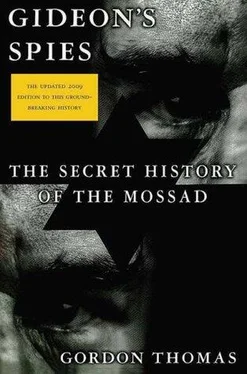Beside the highway between the resort of Herzliyya and Tel Aviv is a compound bristling with antennae. This is Mossad’s training school. Among the first things a new political officer, a spy, at a foreign embassy in Tel Aviv learns is the location of the dun-colored building. Yet, for an Israeli publication to reveal its existence is still to run the risk of prosecution. In 1996 there was a furious debate within the country’s intelligence community about what to do when a Tel Aviv newspaper published the name of Mossad’s latest director general, the austere Danny Yatom. There was talk of arresting the offending reporter and his editor. In the end nothing happened when Mossad realized Yatom’s name had by then been published worldwide.
Meir Amit was firmly against such exposure: “Naming a serving chief is serious. Spying is a secret business and not a pleasant one. No matter what someone has done, you have to protect him or her from outsiders. You can deal as harshly as you think fit with him or her inside the organization. But to the outside world he or she must remain untouchable and, better yet, unaccountable and unknown.”
In his tenure as director general his code name had been Ram. The word had a satisfying Old Testament ring for a boy raised in the unquenchable spirit of the early pioneers at a time when the whole of Arab Palestine was in revolt against both the British Mandate and the Jews. From boyhood he had trained his body hard. Physically slight, Meir Amit became strong and fit, sustained by a belief that this was his land. Eretz Israel, the land of Israel. It did not matter that the rest of the world still called it Palestine until 1947, when the United Nations proposed its partition.
The birth of a nation, Israel, was followed by its near annihilation as Arab armies tried to reclaim the land. Six thousand Jews died; no one would ever be certain how many Arabs fell. The sight of so many bodies all but completed the maturing of Meir Amit. What deepened the process was the arrival of the survivors of the Nazi death camps, each bearing a hideous blue tattoo branded into his or her flesh. “The sight was a reminder of the depth of human depravity.” From others the words would sound inadequately banal; Meir Amit gave them dignity.
His military career was the biography of a soldier destined for the top: a company commander in the 1948 War of Independence; two years later a brigade commander under Moshe Dayan; then, within five years, army chief of operations, the second-ranking officer of the Israel Defense Forces. An accident—the partial failure of his parachute to open—ended his military career. The Israeli government paid for him to go to Columbia University, where he took a master’s degree in business administration. He returned to Israel without a job.
Moshe Dayan proposed Meir Amit should become chief of military intelligence. Despite initial opposition, mostly on the reasonable grounds that he had no intelligence experience, he was appointed: “The one advantage I had was that I had been a battlefield commander and knew the importance of good intelligence to the fighting soldiers.” On March 25, 1963, he took over Mossad from Isser Harel. His achievements had become so many they needed a shorthand of their own: the man who introduced Mossad’s policy of assassinating its enemies; who set up a secret working relationship with the KGB at the very time millions of Jews were being persecuted; who refined the role of women and the use of sexual entrapment in intelligence work; who approved the penetration of King Hussein’s palace shortly before the Hashemite ruler became a CIA spy in the Arab world.
The techniques he created to achieve all that remain in use. But no outsider will ever learn how he first developed them. His jaw muscles tightening, all he would say was: “There are secrets and there are my secrets.”
When the time had come when he felt Mossad could benefit from a new hand at the helm, he had departed with no fuss, called his staff together and reminded them that if ever they found being a Jew and working for Mossad created a problem between their personal ethics and the demands of the state, they should resign at once. Then, after a round of handshakes, he was gone.
But no incoming chief of Mossad failed to call upon him for coffee in his office on Jabotinsky Street, in Tel Aviv’s pleasant suburb of Ramat Gan. On those occasions, Meir Amit’s office door remained firmly closed and the phone switched off.
“My mother always said a trust broken is a friend lost,” he explained in English, smiling an old man’s wily smile.
Outside his immediate family—a small tribe of children, grandchildren, cousins, kith and kin stretching over generations—few really know Meir Amit. He would have it no other way.
On that March morning in 1997, behind his car wheel, Meir Amit looked surprisingly young, closer to sixty than his actual age of seventy-five. The physique that once enabled him to complete a stress test at an Olympian pace had softened; there was a hint of a belly beneath the well-cut blue blazer. Yet his eyes were still sharp enough to startle and impossible to fathom or penetrate as he drove toward an avenue of eucalyptus trees.
How many times he had made this journey even he could no longer count. But each visit reminded him of an old truth: “that to survive as a Jew still means defending yourself to the death.”
The same reminder was on the faces of the soldiers waiting for rides under the trees outside the boot camp at Glilot, north of Tel Aviv. There was a swagger about them, even an insolence; they were doing their compulsory service in the Israel Defense Forces and imbued with the belief they served in the finest army on earth.
Few gave Meir Amit a second glance. To them he was another of the old men who came to remember at a war memorial close to where they waited. Israel is a land of such memorials—over 1,500 in all—raised to the paratroops, the pilots, the tank drivers, and the infantry. The monuments commemorate the dead of five full-scale conventional wars and close to fifty years of cross-border incursions and antiguerrilla operations. Yet, in a nation that venerates its fallen warriors in a manner not seen since the Romans occupied this land, there is no other monument in Israel, indeed the world, like the one Meir Amit helped to create.
It stands just within the perimeter of the boot camp and consists of several concrete-walled buildings and a mass of sandstone walls assembled in the shape of a human brain. Meir Amit chose that shape because “intelligence is all about the mind, not some bronzed figure striking a heroic pose.”
The memorial commemorates so far 557 men and women of Israel’s intelligence community, 71 of whom served in the Mossad.
They died in every corner of the world: in the deserts of Iraq, the-mountains of Iran, the jungles of South and Central America, the bush of Africa, the streets of Europe. Each, in his or her own way, tried to live by Mossad’s motto, “By way of deception, thou shalt do war.”
Meir Amit knew many personally; some he had sent to their deaths on missions he conceded were beyond the “cutting edge of acceptable danger, but that is the regrettable unavoidability of this work. One person’s death must always be weighed against our nation’s security. It has always been so.”
The smooth sandstone walls are engraved only with names and the date of death. There are no other clues to the circumstances in which someone died: a public hanging, the fate of all convicted Jewish spies in Arab countries; a murderer’s knife thrust in an alley that had no name; the merciful release after months of prison torture. No one will ever know. Even Meir Amit could often only suspect, and he kept those dark thoughts for himself.
Читать дальше












